Converting a fisheye image into a panoramic, spherical or perspective projection
Written by November 2004The source code implementing the projections below is only availableon request for a small fee. It includes a demo application and an invitation toconvert an image of your choice to verify the code does what you seek. For more information please contact the .
The following documents various transformations from fisheye into other projectiontypes, specifically standard perspective as per a pinhole camera, panorama andspherical projections.Fisheye images capture a wide field of view, traditionally one thinks of 180degrees but the mathematical definition extends past that and indeed there aremany physical fisheye lenses that extend past 180 degrees. The two main applicationsfor the following are: the inspection of images/video from security cameras wherepanorama or perspective views may be more natural to view, creating panorama orspherical images that are blended together to form even wider field of view images.
The general options for the software include the dimensions of the output image as wellas the aperture of the output panoramic or perspective frustum. Some otherrequirements arise from imperfect fisheye capture such as the fisheye notbeing centered on the input image, the fisheye not be aligned with theintended axis, and the fisheye being of any angle.Another characteristic of real fisheye images is their lack of linearitywith radius on the image, while this is not addressed here as it requiresa lens calibration, it is a straightforward correction to make.
The usual approach for such image transformations is to perform the inverse mapping. Thatis, one needs to consider each pixel in the output image and map backwards tofind the closest pixel in the input image (fisheye). In this way every pixelin the output image is found (compared to a forward mapping), it also meansthat the performance is governed by the resolution of the output image(and supersampling) irrespective of the size of the input image.A key aspect of these mappings is also to perform some sort of antialiasing, thesolutions here use a simple supersampling approach.
The code here are all plain vanilla C tested on Unix style gcc systems (specifically Mac and Linux),but the algorithms/code can readily be modified for otheroperating systems and programming languages.This is not meant to be a final application but rather something you integrate into your code base. Having said that it is wrapped up in a simple TGA image reader/writer for the purposes of algorithm testing, the intent is that one would be implementing the function into ones own code base. They all operate on a RGB buffer (fisheye image) in memory.For each test utility the usage message is provided. The source images for the examplesprovided are provided along with the command line that generated them.
Fisheye to perspective transformation Software: fish2persp
Usage: fish2persp [options] fisheyeimageOptions -w n perspective image width, default = 800 -h n perspective image height, default = 600 -t n aperture of perspective (degrees), default = 100 maximum is 170 degrees -s n aperture of fisheye (degrees), default = 180 -c x y offset of the center of the fisheye image, default is fisheye image center -r n fisheye radius, default is half height of fisheye image -x n tilt angle (degrees), default: 0 -y n roll angle (degrees), default: 0 -z n pan angle (degrees), default: 0 -a n antialiasing level, default = 1 (no antialising) sensible maximum 3
It should be noted at the outset that a fisheye projection is not a "distorted" image, and the process isn’t a “dewarping”. A fisheye like other projections is one of many ways of mapping a 3D world onto a 2D plane, it is no more or less "distorted" than other projections including a rectangular perspective projection ... it is what it is.
Example source fisheye image.
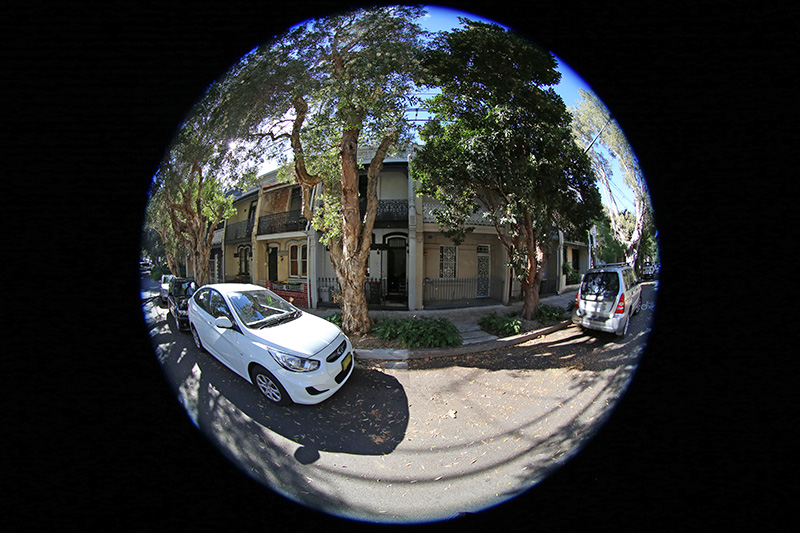
A critical consideration is antialiasing, required when sampling any discrete signal. The approach here is a simple supersampling antialiasing, that is,each pixel in the output image is subdivided into a 2x2, 3x3....grid andthe inverse mapping applied to the subsamples. The final value for the outputpixel is the weighted average of the inverse mapped subsamples.There is a sense in which the image plane is considered to be a continuousfunction. Since the number of samples that are inverse mapped is the principle determinant ofperformance, high levels of antialiasing can be very expensive, typically2x2 or 3x3 are sufficient especially for images captured from video in whichneighbouring pixels are not independent in the first place.For example a 3x3 antialiasing is 9 times slower than no antialiasing.In general the jagged edges are more noticeable in featureswith a sharp colour/intensity boundary.
Default perspective view looking forwards, 100 degrees horizontal field of view.
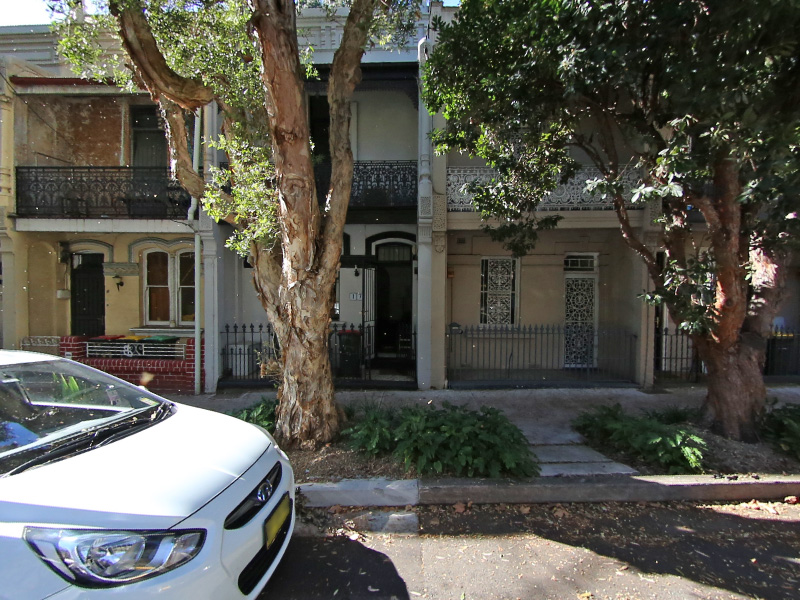 fish2persp -w 800 -a 3
fish2persp -w 800 -a 3 The vertical aperture is automatically adjusted to match the width and height.Controls are provided for any angle fisheye as well as fisheyes that are notlevel or tilted, noting that the exact order of the correction rotations mayneed to be considered for particular cases.Note that a perspective projection is not defined for greater than 180 degrees,indeed it gets increasingly inefficient past around 140 degrees.The field of view can be adjusted as well as the viewing direction.The following example is a 120 degrees horizontal field of view and looking upwards by 30 degrees.
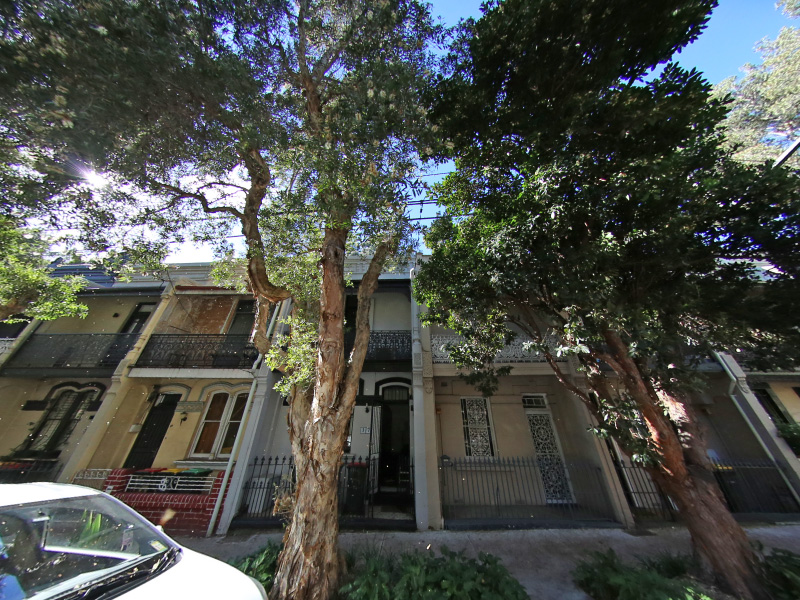 fish2persp -w 800 -a 3 -x 30 -t 120
fish2persp -w 800 -a 3 -x 30 -t 120 If "straight" lines are not straight that normally means the fisheye center or radius are not specified correctly or the angle is not defined correctly.Curvature in what should be straight lines near the rim of the fisheye normally meansthe fisheye lens has non-linearities near the rim (a deviation from the mathematically purefisheye projection) and corrections need to be applied.The following is looking right by 40 degrees and a narrower field of view of 80 degrees.
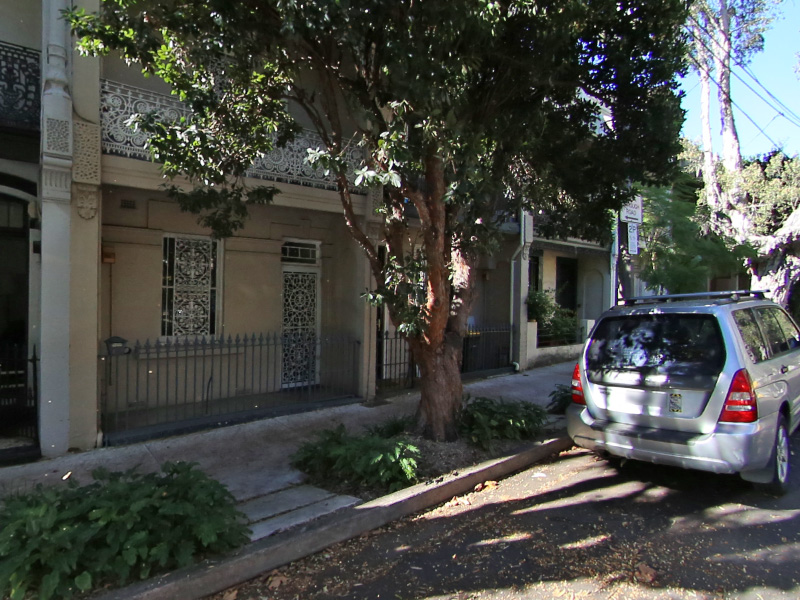 fish2persp -w 800 -a 3 -z 40 -t 80
fish2persp -w 800 -a 3 -z 40 -t 80 The center of the fisheye on the input image can be found by projectinglines along vertical structure in the scene. Where these lines intersectis a close approximation to the center of the fisheye, assuming thecamera is mounted vertically. Alternatively, and perhaps easier, is to identify the edges of thefisheye and assume a perfect circular inscribed circle. Note that for the example utilities providedhere the origin is assumed to be the bottom left corner, unlike the more common top right thatimage editing programs use.
To test the algorithm a fisheye rendering inside a gridded cube is a good example,see image on left below. Any correct perspective projection should result in straight lines.
| Sample input image |
Front pointing fisheye to panorama Software: frontfish2pano
This case is developed mainly for "front pointing" fisheyes although it does have applicationfor other orientations. The projection is more correctly called a cylindrical panorama.
Usage: frontfish2pano [options] fisheyeimageOptions -w n panoramic image width, default = 800 -h n panoramic image height, default = -1 -ap n vertical aperture of panoramic, default = 100 -af n aperture of fisheye (degrees), default = 180 -cf x y center of the fisheye image, default is image center -r n radius of the fisheye image, default is half the image width -fa n angle for tilted fisheye, default = 0 -fb n angle for rotated fisheye, default = 0 -a n antialiasing level, default = 1 (no antialising)
Source fisheye image.
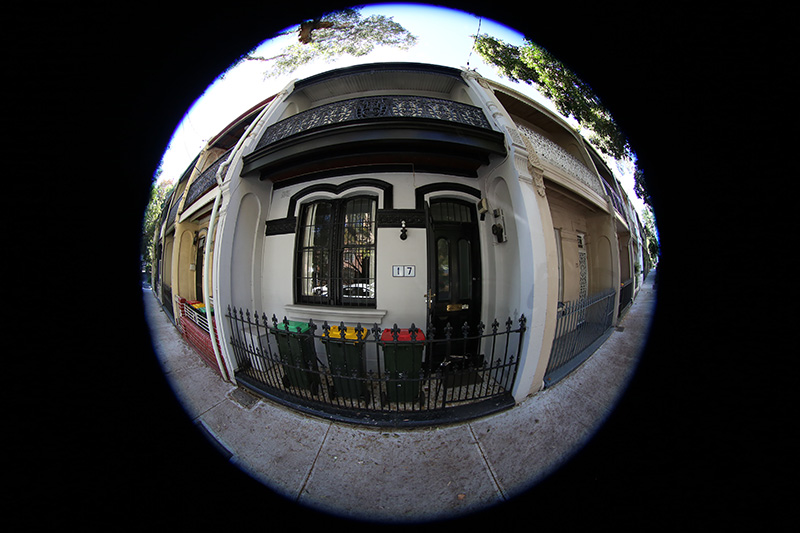
Transformation with the default settings is shown below.
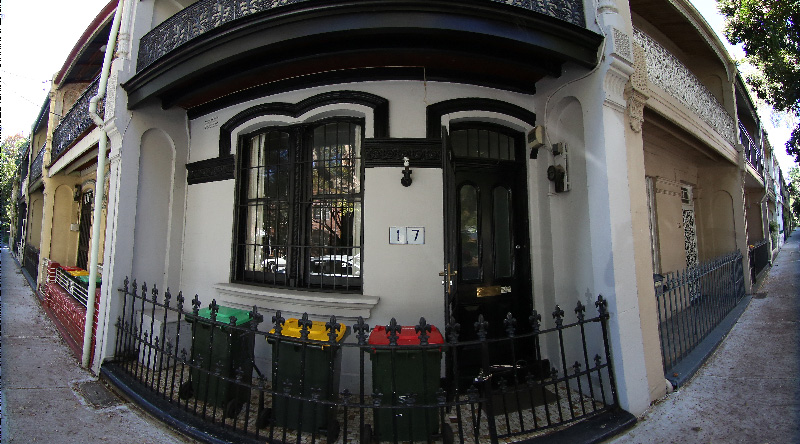 frontfish2pano -a 3 -w 800
frontfish2pano -a 3 -w 800 Correct for the fact that the camera is not quite horizontal, this is thereason the vertical structure doesn't appear vertical in the panoramic projection.Of course nothing is for free, one looses a bit of the image in the bottomleft and right corners.
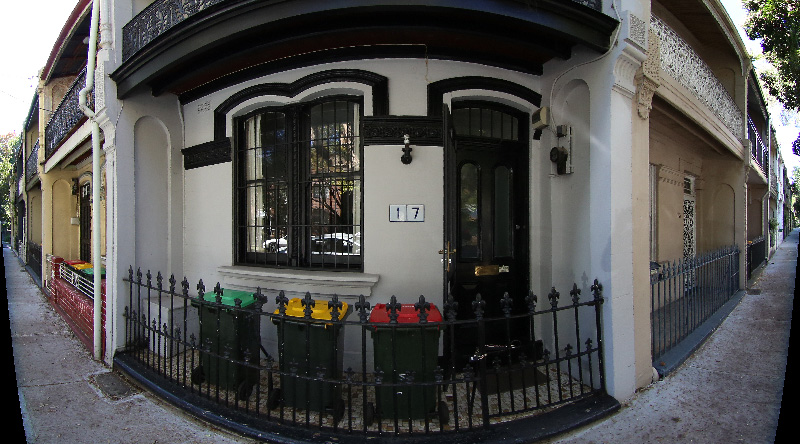 frontfish2pano -a 3 -w 800 -fa -20
frontfish2pano -a 3 -w 800 -fa -20 Set the vertical field of view of the panorama, in the following cases narrowed fromthe default of 100 degrees to 80 degrees. As with perspective projections there is a limit, in this case, to the vertical field of view, a hard limit at 180 degrees but increasingly inefficientpast 140 degrees.
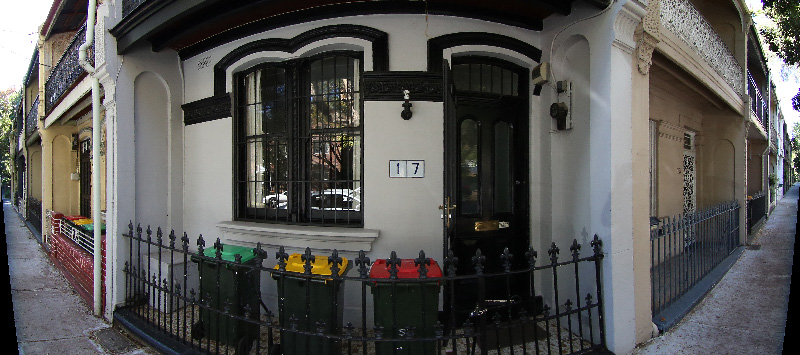 frontfish2pano -a 3 -w 800 -fa -20 -ap 80
frontfish2pano -a 3 -w 800 -fa -20 -ap 80 Fisheye to (partial) spherical projection Software: fish2sphere
Usage: fish2sphere [options] imagefileOptions -w n sets the output image size, default: 4 fisheye image width -a n sets antialiasing level, default: 2 -fa n fisheye aperture (degrees), default: 180 -c x y fisheye center, default: center of image -r n fisheye radius, default: half the fisheye image width -v n rotate fisheye in latitude, default: 0 -z n roll fisheye, default: 0 -d debug mode
Source fisheye image.
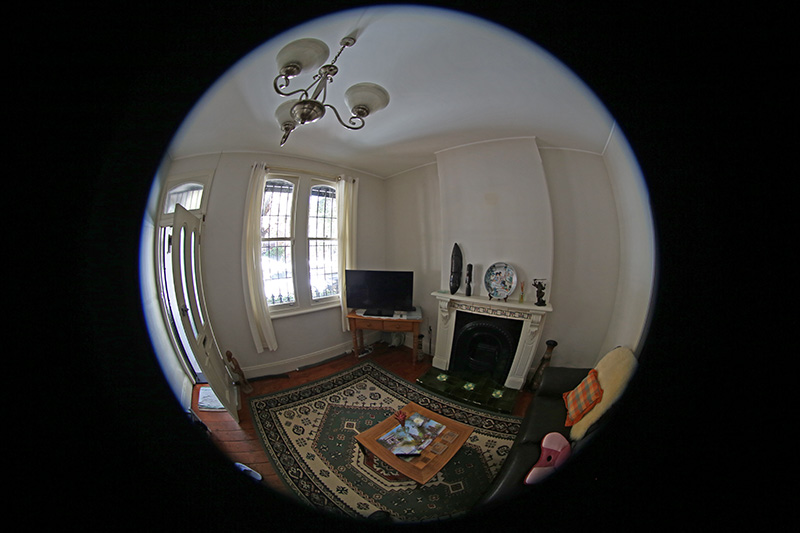
Transformation using the default settings. Since a 180 degree (in this case) fisheyecaptures half the visible universe from a single position, so it makes sense that it occupieshalf of a spherical (equirectangular) projection, which captures the entire visibleuniverse from a single position.

In this case the camera is not perfectly horizontal, this and other adjustmentscan be made. In the example here the lens was pointing downwards slightly, thecorrection results in more of the south pole being visible and less of the northpole.

Note that the fisheye angle is not limited to 180 degrees, indeed one applicationfor this is in the pipeline to create 360 spherical panoramas from 2 cameras, eachwith a fisheye lens with a field of view greater than 180 to provide a blend zone.
This can be readily implemented in the OpenGL Shader Language, the followingexample was created in the.
- // Fisheye to spherical conversion
- // Assumes the fisheye image is square, centered, and the circle fills the image.
- // Output (spherical) image should have 2:1 aspect.
- // Strange (but helpful) that atan() == atan2(), normally they are different.
- kernel vec4 fish2sphere(sampler src)
- {
- vec2 pfish;
- float theta,phi,r;
- vec3 psph;
- float FOV = 3.141592654; // FOV of the fisheye, eg: 180 degrees
- float width = samplerSize(src).x;
- float height = samplerSize(src).y;
- // Polar angles
- theta = 2.0 * 3.14159265 * (destCoord().x / width - 0.5); // -pi to pi
- phi = 3.14159265 * (destCoord().y / height - 0.5); // -pi/2 to pi/2
- // Vector in 3D space
- psph.x = cos(phi) * sin(theta);
- psph.y = cos(phi) * cos(theta);
- psph.z = sin(phi);
- // Calculate fisheye angle and radius
- theta = atan(psph.z,psph.x);
- phi = atan(sqrt(psph.x*psph.x+psph.z*psph.z),psph.y);
- r = width * phi / FOV;
- // Pixel in fisheye space
- pfish.x = 0.5 * width + r * cos(theta);
- pfish.y = 0.5 * width + r * sin(theta);
- return sample(src, pfish);
- }
The transformation can be performed in realtime using warp mesh files forsoftware such as or the VLC equivalent. A sample mesh file is givenhere:. Showing the result in actionis below.
| Test cases for various fisheye apertures. | |
| 180 degree fisheye | |
| 120 degree fisheye | |
| 220 degree fisheye | |
| 220 degree fisheye and 90 degree latitude rotation | |
| | |
| 220 degree fisheye and 60 degree latitude rotation | |
| | |
Fisheye to (full) panorama Software: fish2pano
The following is a slightly more general version of conversion to a panoramic projection.It supports both spherical and cylindrical projections, handles different fisheyeorientations but the main difference is it is designed to image into a full 360 projection obviously withparts not covered because of the limited field of view of a fisheye compared to a fullspherical projection.
Usage: fish2pano [options] fisheyeimageOptions -w n panoramic image width, default = 1024 -h n panoramic image height, default = derived -af n aperture of fisheye (degrees), default = 180 -cf x y center of the fisheye image, default is image center -x n tilt fisheye about x (right) axis, default = 0 -z n rotate fisheye about lens axis, default = 0 -r n radius of the fisheye image, default is half the image width -a n antialiasing level, default = 1 (no antialising) -c cylindrical pano, default is spherical -v n vertical aperture for cylindrical pano, default: 60
Example 1: Source fisheye image.
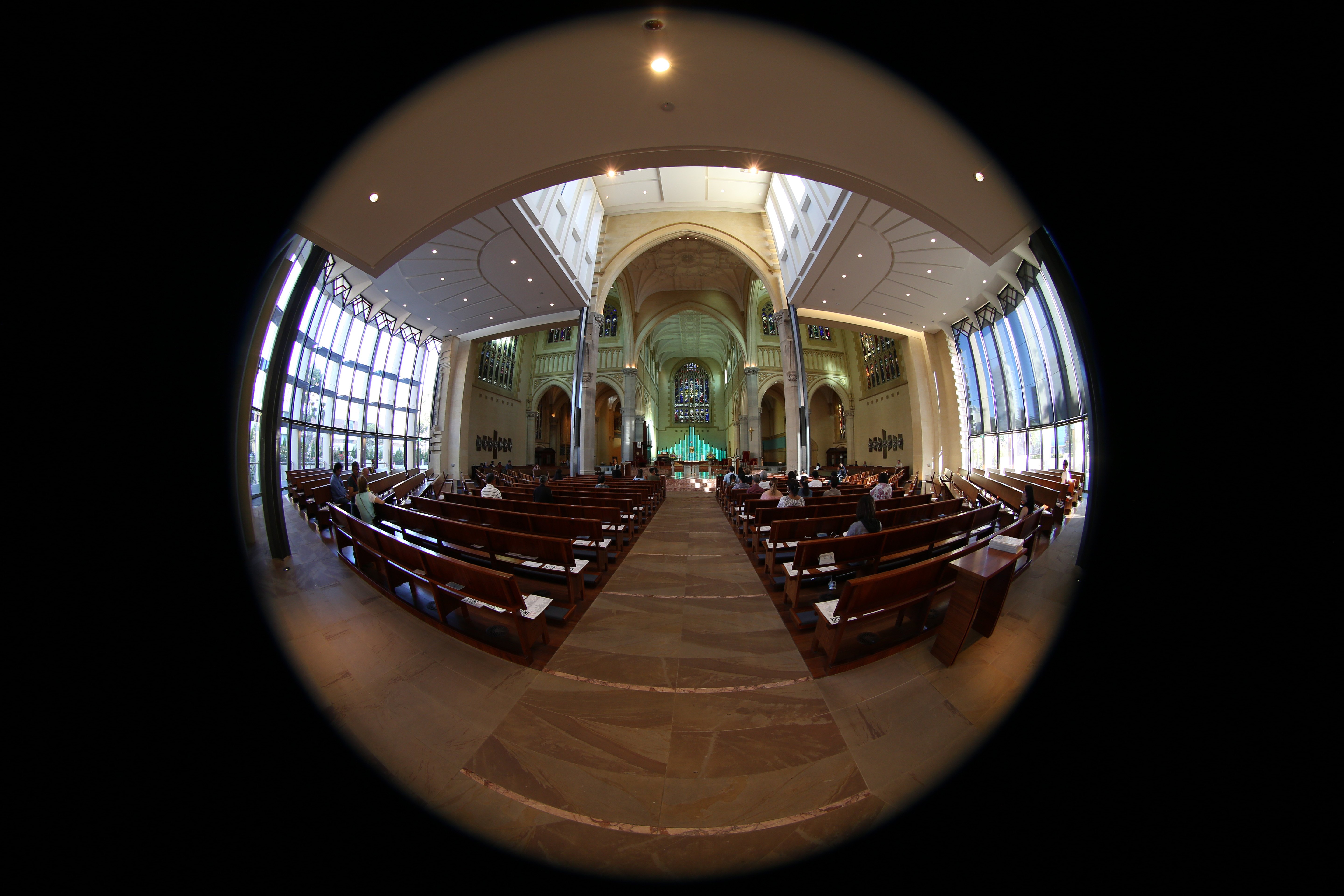
Black refers to the corners of the fisheye image and the grey to the unavailable data,that is, data outside the fisheye rectangle in which the circular fisheye is inscribed.Note that for a wider than 180 degree fisheye the black and grey regions will be correspondingly smaller. The "x" axis is to the right, the 90 degree rotation heregives the desired result for a forward pointing fisheye. A fisheye pointing straightup or straight down would more normally be transformed with "-x 0".
 fish2pano -a 3 -w 800 -x 90
fish2pano -a 3 -w 800 -x 90 Cylindrical projection, vertical field 60 degrees and 100 degrees respectively.The vertical extent of the image is, normally, determined correctly given the vertical field of view requested but that can be overruled if desired.
 fish2pano -a 3 -w 800 -x 90 -c
fish2pano -a 3 -w 800 -x 90 -c 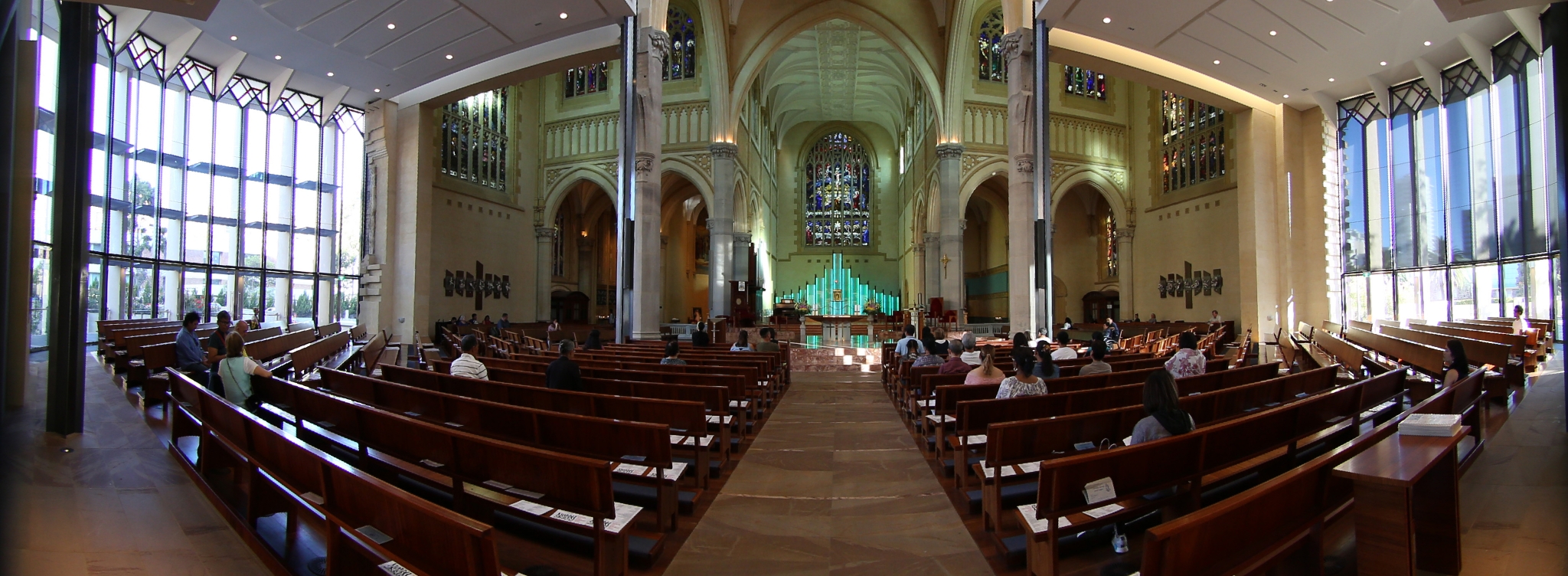 fish2pano -a 3 -w 800 -x 90 -c -v 100
fish2pano -a 3 -w 800 -x 90 -c -v 100 Example 2: Source fisheye image
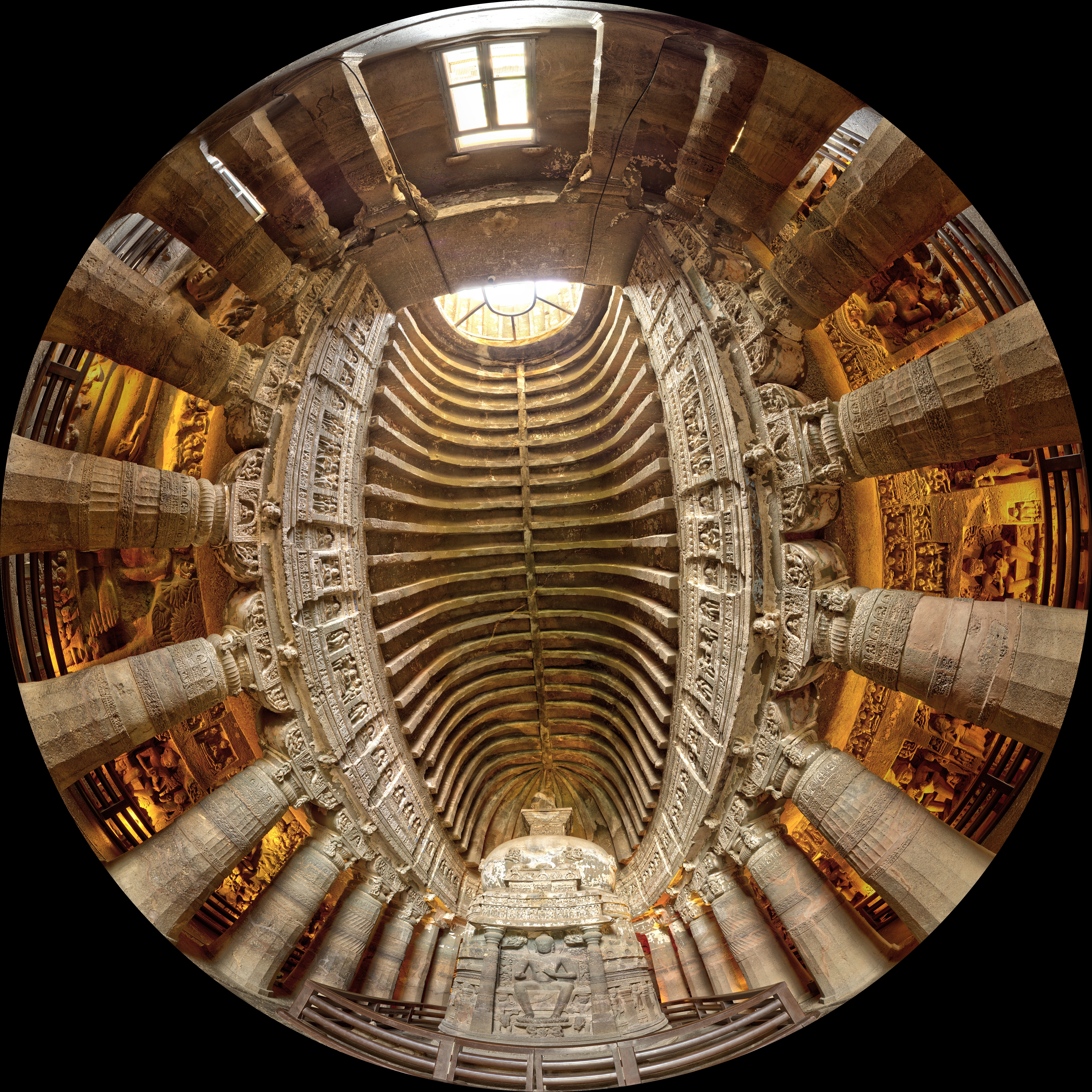
The default settings (no x axis rotation) provide what one expects for an upper hemisphereas per a standard Earth map. Note the apparent distortion towards the north pole, which againis not a strictly distortion but a natural consequence of the mathematics behind the projection.
 fish2pano -a 3 -w 800
fish2pano -a 3 -w 800 Cylindrical panorama with a 100 degree vertical field of view, that is, from the equator (0 degreeslatitude) to 100 degrees latitude.
 fish2pano -a 3 -w 800 -c -v 100
fish2pano -a 3 -w 800 -c -v 100